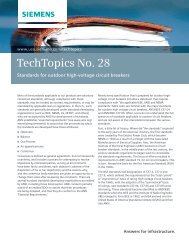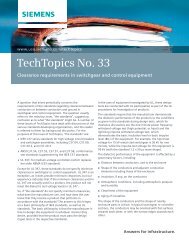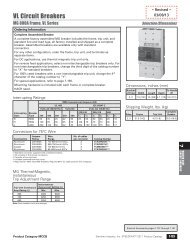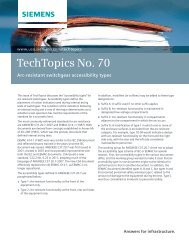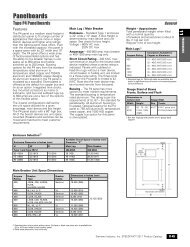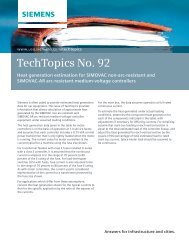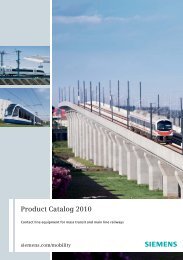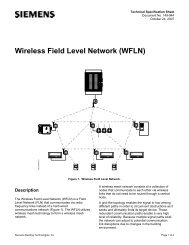Spectrum Power Shared Architecture - Siemens
Spectrum Power Shared Architecture - Siemens
Spectrum Power Shared Architecture - Siemens
- TAGS
- spectrum
- architecture
- siemens
You also want an ePaper? Increase the reach of your titles
YUMPU automatically turns print PDFs into web optimized ePapers that Google loves.
manager via AOA. All messages on the ESBuse MRIDs to identify assets. This serviceallows BSCs to keep local names forinternal processing and display purposes,and to translate these local names toMRIDs for communication with other BSCs.MRID names are converted to BSC localnames via the SA naming service.Log RepositorysyslogContext & StateExternal & StateProviderState QueryContext & State ApplicationValidationSonic ESBContainerContext & StateInternal & StateConsumer/ProviderLifecheckResponseConfigurationData SourceThe naming service may also be used tosupport the exchange of power systemnetwork models with neighboring utilities,Independent System Operators (ISOs) andRegional Transmission Organizations(RTOs).Context and stateA context and state (C&S) application isincluded in the SA. Figure 3 shows anoverview of the C&S applicationcomponents and message flows. C&S usesa service-oriented architecture (SOA) withan ESB to control and manage BSCs. C&Sperforms the following main functions:State QueryResponseLifecheck Lifecheck LifecheckContext &StateServiceProviderBSC-1Context &StateServiceConsumer•Figure 3: Overview of Context & StateContext &StateServiceProviderBSC-2Context &StateServiceConsumer•Context &StateServiceProviderBSC-nESBContext &StateServiceConsumer•• Bookkeeping of BSC states• Bookkeeping of BSC contexts• Bookkeeping of BSC roles• Validation of transitions in states androles that are requested and thoseoccurring spontaneously• Bookkeeping of commands issued andresponses received to ensure correctworkflow.CIM-CIEThe SA uses the IEC CIM as the basis forthe definition of message payloads thatare exchanged over the ESB. As part of anintegration project, BSCs provide adefinition of the input data requirementsand output data provided. This data is usedto define messages and payloads using theIEC CIM (extended where necessary) as adictionary or ontology. The SA includes astandard set of messages that support thefollowing BSCs:eDARTSOA AdapterSOA AdapterRTMSTLFSOA AdapterSOA AdapterFTR/eFTR/RPM/LRCM2M2MSOA AdapterFigure 4: CIM-CIE Standard MessagesSOA AdapterTNAEESSOA Adapter• Real-time locational marginal pricing(RTLMP)• Operator training simulator (OTS)• CIM-compliant Model Manager (IMM)SA also includes a definition of a standardset of services that BSCs provide. TheeORG/ORGSOA AdapterEnterprise Service BusSOA AdapterSCADA/AGCSOA AdapterRTLMPVSA/TSA DAM eDATASOA AdapterSOA AdapterOTSSOA AdapterSOA AdapterIMMSOA Adaptermessages and services are defined inWSDL and XSDs. A utility integrationproject may reuse these standardmessages where appropriate, or use themethods developed to derive newmessages and services.• Outage scheduler (eDART)• Load forecasting (STLF)• Congestion management (CM2/M2M)• Interchange scheduler (EES)• Market registration (eORG/ORG)• Voltage stability analysis/transientstability analysis (VSA/TSA)• Day-ahead markets (DAM)• Real-time markets (RTM)• Financial Transmission Rights (FTRs)Auction load response, reliability pricing• Transmission network analysis (TNA)• SCADA/automatic generation control(AGC)TNA SCADADetectSCADAEvent+BroadcastEvent+ReceiveEvent+Execute StateEstimator?YesNoReceiveSCADADataRequestRequestSCADAData+ExecuteStateEstimator+BroadcastStateEstimatorResults+Figure 5: Business Process Orchestration




